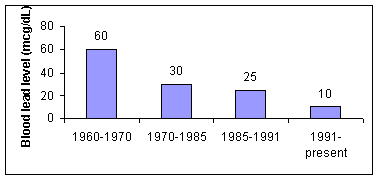Agency for Toxic Substances and Disease Registry
| |||||||||||||||||||||||||||||||||||||||||||||||||||||||||||||||||||||||||||
Learning Objectives |
Upon completion of this section, you will be able to
|
Introduction |
Because of lead’s importance as a cause of public health problems, a number of federal agencies have issued advisory standards or enforceable regulations that set lead levels in different media. The table below summarizes these standards and regulations for 2006; see subsequent sections for further explanation. |
Biologic Guidelines |
As new information has emerged about the neurological, reproductive, and possible hypertensive toxicity of lead, and as parameters that are more sensitive are developed, the BLLs of concern for lead exposure have been progressively lowered by CDC. (See Figure 1 below).
Ten µg/dL (micrograms /deciliter) was adopted by CDC in 1991 as an action level for children, an advisory level for environmental and educational intervention.
The Biological Exposure Index (BEI) is a guidance value for assessing biological monitoring results. The BEI for blood lead is 30 µg/dL. (ACGIH 2005) The BEI indicates exposure at the Threshold Limit Value (TLV) (See “Workplace Air” below). |
Physician Reporting Requirements |
Most states ask or require primary care physicians and persons in charge of screening programs to report both presumptive and confirmed cases of lead toxicity to the appropriate health agency. This is to ensure
In some states, the clinical laboratories performing blood lead testing are required to report cases of lead toxicity. Even if not required, a physician should strongly consider consulting a health agency in the case of lead toxicity, as health agencies are important sources of resources and information. In some states, laboratories performing BLL or EP (ZPP) tests are also required to report abnormal results to the appropriate health agency. |
Workplace Air |
The OSHA Lead Standard specifies the permissible exposure limit (PEL) of lead in the workplace, the frequency and extent of medical monitoring, and other responsibilities of the employer. OSHA has set a PEL (enforceable) of lead in workplace air at 50 µg/m3 averaged over an 8-hour workday for workers in general industry.
A copy of the lead standard can be obtained by calling your regional office of OSHA or from the CFR website (www.gpoaccess.gov/cfr/index.html). NIOSH at CDC has set a Recommended Exposure Limit (REL) of 50 µg/m3 to be maintained so that worker blood lead remains < 60 µg/dL of whole blood. http://www.cdc.gov/niosh/npg/npgd0368.html. The ACGIH has set a threshold limit value for a time-weighted average (TLV/TWA) of 50 µg/m3 for lead in workplace air (except for lead arsenate). http://www.acgih.org/home.htm. |
Soil |
Lead contaminated soil can pose a risk through direct ingestion, uptake in vegetable gardens, or tracking into homes.
The soil screening level (SSL) for lead represents a conservative estimate for a level that would be protective of public health in residential soils based on an analysis of the direct ingestion pathway for children. This value is for guidance only and is not enforceable. |
Drinking Water |
EPA has set drinking water standards with two levels of protection.
For further information, call the EPA Safe Drinking Water Hotline toll-free at 1-800-426-4791. http://www.epa.gov/safewater/ The use of lead solder and other lead-containing materials in connecting household plumbing to public water supplies was banned by EPA as of June 1988.
|
Food |
FDA has set a number of action levels (enforceable) and levels of concern for lead in various food items. These levels are based on FDA calculations of the amount of lead a person can consume without ill affect.
|
Paint |
White house paint contained up to 50% lead before 1955. Federal law lowered the amount of lead allowable in paint to 1% in 1971. The CPSC has limited since 1977 the lead in most paints to 0.06% (600 ppm by dry weight). Paint for bridges and marine use may contain greater amounts of lead. |
| Table 3: Standards and Regulations for Lead | |||
|---|---|---|---|
| Agency | Media | Level | Comments |
CDC |
Blood |
10 µg/dL |
Advisory; level for individual management |
OSHA |
Blood |
40 µg/dL |
Regulation; cause for written notification and medical exam |
ACGIH |
Blood |
30 µg/dL |
Advisory; indicates exposure at the threshold limit value (TLV) |
OSHA |
Air (workplace) |
50 µg/m3 |
Regulation; PEL (8-hr average.) (general industry) |
CDC/NIOSH |
Air (workplace) |
100 µg/m3 |
REL (non-enforceable) |
ACGIH |
Air (workplace) |
150 µg/m3 |
TLV/TWA guideline for lead arsenate |
EPA |
Air (ambient) |
1.5 µg/m3 |
Regulation; NAAQS; 3-month average |
EPA |
Soil (residential) |
400 ppm (play areas) |
Soil screening guidance level; requirement for federally funded projects only (40 CFR Part 745, 2001) |
EPA |
Water (drinking) |
15 µg/L |
Action level for public supplies |
FDA |
Food |
Various |
Action levels for various foods; example: lead-soldered food cans now banned |
CPSC |
Paint |
600 ppm (0.06%) |
Regulation; by dry weight. There is a new standard for lead in children’s jewelry. |
Key Points |
|
Progress Check |
|




